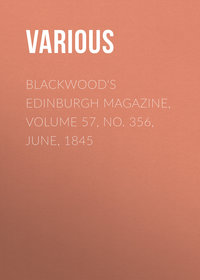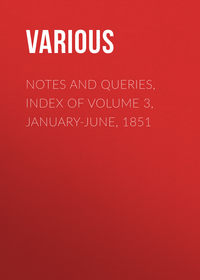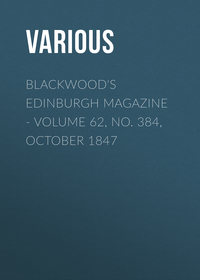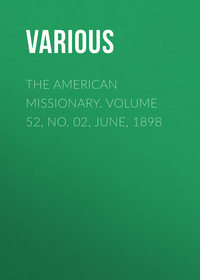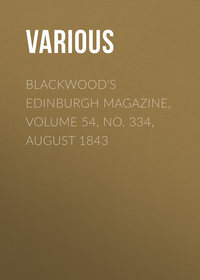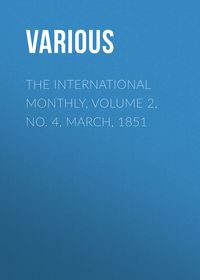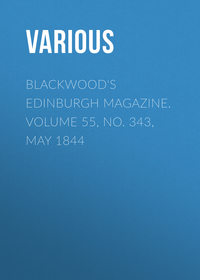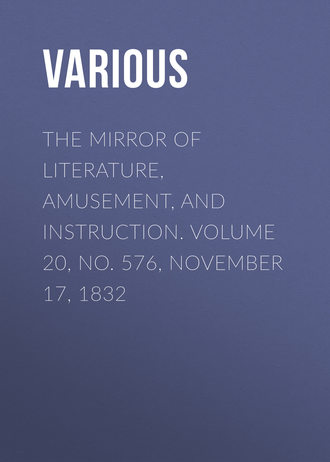 полная версия
полная версияThe Mirror of Literature, Amusement, and Instruction. Volume 20, No. 576, November 17, 1832

Various
The Mirror of Literature, Amusement, and Instruction / Volume 20, No. 576, November 17, 1832
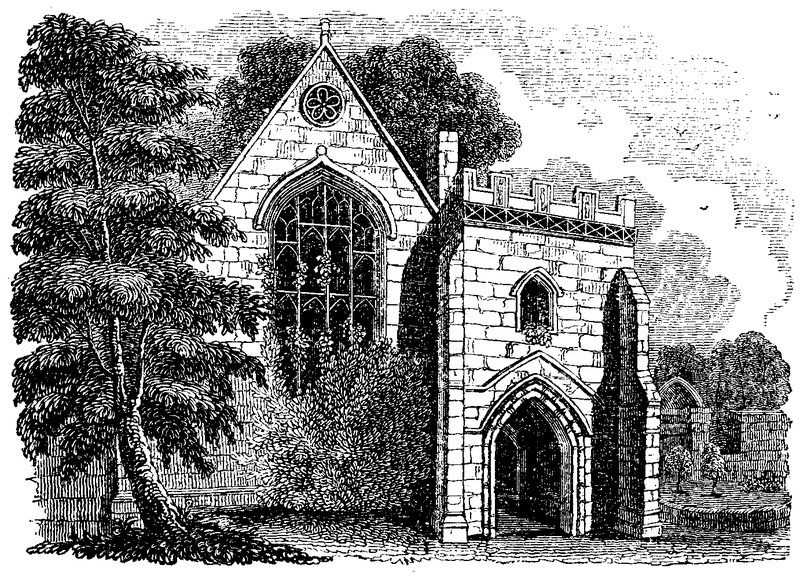
WINGFIELD MANOR-HOUSE
This interesting structure is referred to by a clever writer1 as one of the richest specimens extant of the highly-ornamented embattled mansions of the time of Henry VII. and VIII., the period of transition from the castle to the palace, and undoubtedly the best aera of English architecture. This judgment will be found confirmed in the writings of distinguished antiquarians; and the reader's attention to the descriptive details of this building will be important in connexion with several notices, in our recent pages, of old English domestic architecture.
The manor of Wingfield, or Winfield, is situated four or five miles to the eastward of the centre of Derbyshire. The early lords had two parks, which, according to a survey made in 1655, contained nearly 1,100 acres. These parks are now divided into farms: on the border of one of them are a moat and other remains of an ancient mansion, traditionally said to have been called Bakewell Hall; by some, this is supposed to have been the original mansion, which is said by others to have been near the Peacock Inn, on the road between Derby and Chesterfield. The present Manor-House, (as represented in the Engraving,) according to Camden, was built about the year 1440, by Ralph, Lord Cromwell, in the time of Henry VI. This Lord Cromwell was treasurer of England; and the testimony of Camden that he was the founder, is strongly corroborated by the bags or purses of stones, (alluding to the office of treasurer which he filled,) carved over the gateway leading into the quadrangle. Bags or purses are mentioned to have been carved on the manor-house of Coly Weston, in Northamptonshire, augmented by this Lord Cromwell; and there were also similar ornaments carved in wood, removed about a century ago from Wingfield Manor.
The Manor-House originally consisted of two square courts, one of which, to the north, has been built on all sides, and the south side of it forms the north side of the south court, which has also ranges of buildings on the east and west sides, and on part of the south. The latter court seems principally to have consisted of offices. The first entrance is under an arched gateway on the east side of the south court. The arch of this gateway being a semicircle, was probably erected subsequently to the rest of the building: hence the communication with the inner court is under an arched gateway in the middle of the north side of the south court. One half of this range of building seems originally to have been used as a hall, which was lighted by a beautiful octagon window, and through a range of Gothic windows to the south, now broken away, and a correspondent range to the north. This part of the house was afterwards divided and subdivided into several apartments: these have suffered the same fate as the noble hall, the magnificence of which their erection destroyed. In the other part of this range are the portal, the remains of the chapel, and of the great state apartment, lighted by another rich Gothic window. Little or no part of the east side of the building remains; and only the outer wall and some broken turrets were a few years since, standing on the west side of the north court.
In the thirty-third year of the reign of Henry VIII. it appears that Wingfield Manor was in the possession of the Earl of Shrewsbury; and in the time of Queen Elizabeth, the Earl of Shrewsbury held in his custody here the unfortunate Mary, Queen of Scotland. Her suit of apartments, tradition informs us, was on the west side of the north court. This, in the memory of persons living but a few years since, was the most beautiful part of the building: it communicated with the great tower, whence it is said the ill-starred captive had sometimes an opportunity of seeing the friends approach with whom she held a secret correspondence; and "this tradition appears to have been founded upon good authority."2 It is inferred that her captivity at Wingfield commenced in 1569, in which year an attempt was made by Leonard Dacre to rescue her; after which, Elizabeth, becoming suspicious of the Earl of Shrewsbury, under pretence of his lordship's being in ill health, directed the Earl of Huntingdon to take care of the Queen of Scots in Shrewsbury's house; and her train was reduced to thirty persons. This event happened the year after Mary was removed from Bolton Castle, in Yorkshire, to Tutbury Castle, in Staffordshire, and placed under the care of the Earl of Shrewsbury. Her captivity at Wingfield is stated to have extended to nine years; but it is improbable that so large a proportion of the time she was in the custody of this nobleman, should be spent here: for it is well known, that from 1568 to 1584, she was at Buxton, Sheffield, Coventry, Tutbury, and other places, and, if her confinement here continued so long, it must have been with many intervals of absence.
The Manor-House continued to be the occasional residence of the Shrewsburys till the death of Earl Gilbert, in the year 1616, who dying without male issue, the whole of his estates in this part of the kingdom descended to his three daughters and co-heirs by marriage, and their descendants, till one of the latter, the Hon. Henry Howard, becoming Duke of Norfolk, sold his portion to different tenants; and in the year 1666, we find Mr. Emanuel Halton resident at the Manor-House. He was a man of considerable literary and scientific attainments, as well as of good family, his father being sheriff of Cumberland in 1652. Being employed as auditor to Henry, Duke of Norfolk, he was, through that connexion, introduced into Derbyshire, and spent the latter part of his life, which was devoted to music and mathematics, at Wingfield. In the Appendix to Foster's Mathematical Miscellanies are some of his pieces. In the year 1676 he observed an eclipse of the sun at Wingfield, which was published in the Philosophical Transactions for that year. The Manor was, in 1817, in the possession of Wingfield Halton, Esq., great grandson of the aforesaid Emanuel; but it was not then inhabited. The last of the Halton family who resided at the Manor-House became its spoiler; for, desiring to build himself a house at the foot of the high hill upon which the mansion stands, he pulled down and unroofed part of the fine old structure—so that the hall, with its proud emblazonry of the Shrewsbury arms and quarterings, became exposed to the decaying influences of the elements.3 The mansion had been, however, previously much injured during the civil wars, in the reign of Charles I.; and there are a few singular incidents in its fate. The house being possessed by the royal party, was besieged and taken by Lord Grey, of Groby, and Sir John Gall, of Hopton—brave officers in the service of the parliament, who, according to Whitelock, voted them a letter of thanks for this and other services. The assault was begun on the east side, with cannon planted on Pentridge Common, and a half-moon battery raised for its defence in this quarter was soon carried; but a breach being found impracticable, the cannon were removed to a wood on the opposite side. They soon opened a considerable breach in the wall, and captured the place. Colonel Dalby, who was the governor, was killed during the siege. He had disguised himself in the dress of a common soldier, but being seen and known by a deserter, he was shot by him in the face as he walked in one of the stables. The hole through which the assailant introduced his murderous musket might lately be seen, near the porter's lodge.
POSTS FOR THE CONVEYANCE OF LETTERS
Posts of some kind or other appear to have been in extensive use, and to have been held in high importance, by all civilized nations, from an early period of history to the times we live in. Attempts were at first made to carry on correspondence by the means of pigeons and other birds, and though the attempt did not altogether fail, yet it was never carried into extensive practice, and in the progress of time was totally disused. The first establishment of Posts can be traced to the times of the ancient Persians. The honour of their invention is ascribed to Cyrus. It appears that on his conception of his Scythian expedition, he caused certain Post-houses to be erected on all the principal roads. These houses were a day's journey from each other; and Cyrus employed horsemen to convey the intelligence from the army to the first Post-house, and so to the second and third, till the end of the Post-houses, which was at Susa. The news of his victories was thus conveyed to his people in an almost incredible space of time. The Greeks were also in the possession of regular posts, but we have no data from which we can judge of the manner in which they were conducted, who founded them, or where they were first established.
At Rome, Posts and Post-houses were established, and designated statores and stationes; they were founded by the senate at a very early period of the Republic. They were at first very ill managed, the delivery of the post being extremely irregular, and confined to the great roads; but Augustus extended them throughout all parts of his mighty empire, and issued commands which appointed certain days for the delivery of the posts. At their first establishment the Posts were carried by young men on foot, who were met by others at the appointed post stations, but horses and chariots were substituted in their stead by Augustus.
The earliest institution of Posts in modern times was about the year 807. Charlemagne after he had subjugated to his power Germany, Italy, and a large part of Spain, seeing the inconvenience which the Government suffered from the non-delivery of important despatches from the governors of these distant parts of his dominion, caused Posts to be established at the expense of the people; but like the majority of the wise institutions of this warrior-statesman, shortly after his decease, they were discontinued, and till a long period after no traces are to be found of similar establishments. It is highly probable that they were re-instituted in the year 1484, by Louis XI. who employed in this department 230 couriers and messengers. Succeeding kings instituted officers expressly to superintend the Posts, as great abuses had crept in from time to time, but the multiplicity of the new made officers, and the frequent changes in the organization of the Post Office, kept the public from putting any faith in it, and it had almost ceased to exist when some spirited official men by organizing a new plan, and by giving a certainty to the public of the delivery of their letters, saved it from discontinuance.
From France the institution gradually spread over the other countries of Europe. In Germany, which country was one of the first to adopt the system of the French Posts were established through the influence and at the expense of Count Taxis, who was denominated "the Patriot." The wishes of the people caught the heart of the Emperor Matthias, who to reward Taxis for his public spirit, gave him the office of Post-master, and assigned it to his descendants for ever.
In England Posts appear to have been established as early as the reign of Edward III.; but the records of them handed down to us are obscure and uncertain. In the reign of Edward VI. they were however in full vigour: an Act of Parliament passed in 1548, which we have now before us, fixes the rate of postage at one penny per mile. The Posts here referred to were only used on important occasions. James I. erected a Post Office, which he placed under the control of Matthew de Questor; the office was claimed by Lord Stanhope, whose claim, however, was disallowed; but owing to the detection of de Questor in some mal-practices, the office was given and confirmed to W. Frizee and Thos. Witherings. In the year 1635, Charles I. erected a letter-office for England and Scotland, which he placed under the direction of the before-mentioned Thomas Witherings, who conducted it honourably, but was afterwards superseded for supposed abuses—a charge which was never proved. The rate paid about that time was "twopence for a letter, from 30 to 140 miles." The Posts then established were shortly after extended to the principal roads of England, and were from time to time increased, till they were spread over the kingdom, to the great benefit of a commercial people.
The Post Office forms one of the chief branches of the revenue, and the total received for the conveyance of letters during the last quarter amounted to 33,000l.
The present arrangements of the Post Office, at least as far as they are known, the certainty of the transmission of letters, the economy with which it is conducted, are the theme of admiration by the nation at large, and more particularly by foreigners.
E.J.H.
ETHELBERT AND ELFRIDA. AN HISTORICAL TALE
Night wanes apace!—The crowd are gone;The lamps have ceased to glow;And Cynthia's beams reflect uponThe placid lake below.The song of mirth is heard no more;No guests the goblet fill;The banquet's revelry is o'er,All—all is hush'd and still.No more, amid the stately pile,The dance afford's delight;Nor tale, nor jocund sports beguileThe silent hours of night.All seek the downy couch of sleep—The host, and worthy guest;The drowsy guards on duty keep,And envy them their rest.No minstrels strike th' enliv'ning string—None blow the twanging horn;The nightingale has ceas'd to sing,And slowly breaks the morn.The portals of the dappled EastAssume their bright array;The Sun, in new-born splendour drest,Drives sable clouds away.Thick vapours from the earth arise,And pass away unseen,Till night again shall veil the skies,Now lucid and serene.Above proud Offa's gate the goldEmbroider'd banners hung—And 'scutcheon'd shields emblazon'd toldFrom whence his race had sprung!The glitt'ring lance and crested plumeAdorn the sculptur'd wall,And deep'ning shadows cast a gloomAround his spacious hall!On "South Town's" "heav'n directed" fanesSol sheds his glowing ray;And Peace, and Joy, through Mercia's plainsTheir gladsome sceptre sway.How diff'rent far the scene will beWhen night appears again;—O'er all now reigns festivity,But lamentation then!A richly silver-braided vestThe virgin train prepare—A scarf, to wrap the snow-white breast,And gems to deck the hair.Elfrida, at her lattice high,Sits with the bridal throng—She looks and looks—then heaves a sigh—"Why tarries he so long?"He comes!—'tis he!—and by his sideAttend a noble band—He comes to claim his royal bride—His lov'd Elfrida's hand.The wish'd-for hour is gone and past;—Slow chimes the marriage-bell;May Heav'n forbid it prove his last—The bridegroom's fun'ral knell!The priest before the altar stands—The bride bends on her knee,And lifts to God her heart and handsIn pious fervency!But where is he, who should have kneltBefore his Maker, low?And where are they, who might have feltWhat none but parents know!In vain she waits, and looks around,Still vainer are her cries;With shrieks the sacred aisles resound;—Save echo, naught replies:Fell grief her throbbing heart enthrals,—Her lips grow ghastly pale;She weeps—she faints—and senseless fallsBefore the altar-rail!But where is he, by whom the vowsOf love were pledg'd so late?Demand of Offa's artful spouse,Whose fiat seal'd his fate?The blush of guilt upon her cheekSpreads forth its purple hues,—And agitation seems to speakWhat conscience dares refuse!To Him who gives life's fleeting breathHis soul has ta'en its flight!—He sleeps the last long sleep of deathUpon his bridal night.His guards were gone;—no friends were nearTo bless him ere he died!None, none to dry the falling tear,Or bid his pains subside.Oh! where is she whom fate hath madeDejected and forlorn?She goes to Croyland's hallow'd shade,To live—alas!—to mourn!Weep, Anglia, weep!—thy monarch's dead!To heav'n his spirit's flown;And he whose hands his blood have shedWill mount thy vacant throne.He reigns!—but mark! how self-reproachPervades his inmost breast;—And pangs of sad remorse encroachUpon his fever'd rest.He lives—but life has little left,If aught, his love to claim;Of all, save grief, 'tis now bereft;To him 'tis but a name!J.H.I.The event which the foregoing stanzas have attempted to describe laid the foundation of the future importance and prosperity of the Cathedral church of Hereford.
"The restless ambition of Offa prompted him to attack the neighbouring kingdom of the East Angles, with a view of adding it to his dominions; but in this attempt he was defeated by the successful valour of Ethelbert. Peace being subsequently concluded, Offa acceded to proposals of marriage between Ethelbert and his daughter Elfrida;—and the young and unsuspecting prince attended, invited, at the palace of Offa (at South Town, now Sutton, near Hereford), with a splendid retinue, to treat of the intended spousals. The queen of Offa, Quendreda, is recorded to have prevailed upon her husband to violate the ties of hospitality and humanity; and Ethelbert was treacherously murdered, A.D. 793. His guards and retinue were dispersed; his kingdom, taken by surprise, was annexed to the state of Mercia. The faithful Elfrida retired to Croyland Abbey; and Offa, seized with remorse, sought to appease his wounded conscience by actions which, at that time, were thought to atone for the deepest delinquency. He caused the body of Ethelbert to be removed from Marden, where it had been previously interred, to the cathedral of St. Mary, at Hereford, erecting over him a magnificent tomb, and endowing the church with valuable gifts, chiefly situated in the immediate vicinity of his own palace. The known virtues of the murdered prince caused his shrine to be visited as that of a martyr; and such was the fame of his miracles, that the city and cathedral attained a degree of opulence from the pious contributions of devoted pilgrims."
Wright's History of Hereford.
It is not asserted that Ethelbert was murdered on the day appointed for his marriage; but poetical license will, it is hoped, be pardoned for the variation, whilst the principal facts are strictly adhered to.
RETROSPECTIVE GLEANINGS
PARLIAMENTS
(Concluded from vol. xvii.)In 833, a parliament was held at London, in the presence of King Egbert, with his son Ethelwolf, and Withlaf, the tributary King of Mercia, and most of the prelates and great men of the realm, to deliberate on the best means they could adopt to prevent the Danes from invading England.
In 1210, King John summoned a parliament to meet him at his palace in St. Bride's parish, London; where he exacted of the clergy and religious persons the sum of 100,000l., and 40,000l. in particular from the white monks. The present hospital of Bridewell stands on a part of that palace.
In 1294, Edward I., in order to raise funds for the invasion of Scotland, addressed writs to the sheriffs, directing them to send "representatives for every city and borough in their bailiwicks." Many of the boroughs at this time, on account of the expense of paying their representatives, declined to send members; but the King took care for his own purposes that the Royal and other boroughs where his influence extended, should send members: hence in Cornwall and the other counties on the same coast, where the King's power and property chiefly lay, on account of the mines and tallages, almost every village sent representatives.
In 1414, the fifth year of the reign of Henry IV., the Commons proceeded in their design of regulating the King's household, with whom the Lords accorded; and they required that four persons should be removed out of the King's house,—namely, the Abbot of Dore, the King's confessor, with Durham and Crosbie, gentlemen of his chamber. On February 9, 1414, the confessor, Durham and Crosbie, came into the parliament before the King and the Lords, when his Majesty took occasion to excuse those officers himself, saying, that he knew no cause why they should be removed, but only because they were hated by the people: yet he charged them to depart from his house, according to the desire of his Commons, and would have proceeded in the same manner against the Abbot of Dore, had he been present. The printed roll of Parliamentary proceedings adds these remarkable expressions:—"And our Lord the King moreover said that he would see that the Same measures were taken with regard to any one about his Royal person, who might incur the hatred or indignation of his people." A proceeding similar to this took place in 1451, when Henry VI., at the request of the House of Commons, removed from his court and presence several individuals of either sex, against whom there was universal noise and clamour.
On November 27, 1621, the House of Lords sentenced John Blount to pillory, imprisonment, and labour for life, for counterfeiting a Lord's protection. This was the first case of imprisonment beyond the session, by the House of Lords. The first precedent for their infliction of fines appears about two years afterwards, when they sentenced one Morley to pay 1,000l., and condemned him to the pillory for a libel on the Lord Keeper.
The number of Bishops having seats in the House of Lords is thirty; namely, the two English archbishops, twenty-four English bishops, and four Irish bishops; and they all sit in the house, not as churchmen, or peers representing the clergy, in their various grades, (for these are all represented with the commonalty in the lower House,) but as soldiers, that is, as barons holding certain land by military tenure—tenants in capite per baroniam; and therefore compelled, under the feudal system, by which they were created, to furnish their quota of knights, or men-at-arms, and do other military service to the crown.
The following account of the manner of speaking and voting by the Lords and Commons, is given in A Key to both Houses of Parliament:
"In the House of Lords, the Peers give their votes or suffrages, by beginning with the lowest baron; and so on with the rest, seriatim, until all have expressed their opinions; each one answering apart, 'Content,' or 'Not Content.' If the affirmatives and negatives should happen to be equal in number, the question is invariably presumed to be in the negative, (semper praesumitur pro negante,) and the Not Contents have the effect of an absolute majority. In the House of Commons, the members vote by Ayes and Noes, altogether: but if it be doubtful which is the greater number, the House divides. If the question be whether any bill, petition, &c. is to be brought into the House, then the Ayes, or approvers of the same, go out; but, if it be upon anything which the House is once possessed of, the Noes go out. Upon all questions where the House divides, the Speaker appoints four tellers—two of each opinion; who, after they have told or numbered those within, place themselves in the passage between the Bar and the door, in order to tell those who went out; who, till then, are not permitted to re-enter the House. This being done, the two tellers who have the majority take the right hand, and all four placing themselves within the bar, make three reverences as they advance towards the table, where they deliver the written numbers, saying, 'the Ayes that went out are so many: the Noes who remain are so many:' and vice versa as it may happen. This the Speaker repeats, declaring the majority.
"In a committee of the whole House, the way of dividing is by changing sides, the Ayes taking the right, and the Noes taking the left hand of the Speaker's chair. On such occasions there are but two tellers.
"In each House the act of the majority binds the whole. This majority is openly declared, and the votes, with the names of their authors attached, are generally published in the newspapers; so that the people at large are well enabled to judge of the conduct of their legislators and representatives. This notoriety doubtless produces a very beneficial effect in preserving the integrity of the members of both houses. It is true that when the House of Commons is about to divide, the speaker orders the gallery to be cleared, and all strangers are compelled to withdraw, that the members may be free from popular influence in giving their votes. But, as tellers are appointed to count the votes on each side, there can be no collusion or deception in the decision of any question; at the same time, this method is attended with sufficient publicity for every constitutional purpose. Indeed, it has ever been held the law, rule, and usage of the House of Commons, that all strangers are there only by sufferance, consequently, whenever a member gives notice to the Speaker that he perceives a stranger or strangers, it is the invariable custom of the latter to order them to withdraw; otherwise the sergeant-at-arms will take them into custody, and so enforce the Standing Orders of the House for their exclusion. The publication of the speeches and votes delivered in Parliament is a modern practice, and certainly a breach of the privileges of the members; consequently it may at any time be prohibited by the enforcement of the Standing Orders of either House.


